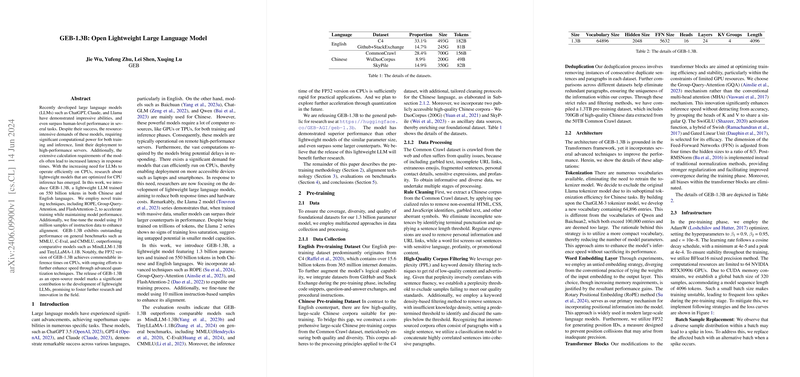Overview of GEB-1.3B: Open Lightweight LLM
The paper presents GEB-1.3B, a lightweight LLM designed to be efficient on CPUs. Unlike many contemporary LLMs which are resource-intensive and typically run on high-performance servers, GEB-1.3B offers a significant advancement by enabling deployment on more accessible devices, such as laptops and smartphones. This essay provides an expert analysis of the methodologies, results, and future implications as elucidated in the paper.
Model Architecture and Training Techniques
GEB-1.3B is engineered with 1.3 billion parameters and trained on a diverse corpus of 550 billion tokens across both Chinese and English languages. The training employs several advanced techniques including ROPE, Group-Query-Attention (GQA), and FlashAttention-2 to expedite the training process while preserving model performance.
Key architectural decisions include a custom tokenizer from the ChatGLM-3 model, a relatively compact vocabulary of 64,896 entries, and an untied embedding strategy that utilizes Rotary Positional Embedding (RoPE). The transformer blocks adopt GQA instead of traditional multi-head attention, enhancing inference speed without detracting from accuracy. The model employs SwiGLU as the activation function and Post-RMSNorm for normalization, optimizing for effective convergence.
The training infrastructure incorporates BFloat16 mixed precision on 64 NVIDIA RTX3090ti GPUs with a global batch size of 320 samples. Stability measures such as Batch Sample Replacement, Iteration Skipping, Embedding Layer Gradient Shrinkage, and Learning Rate Adjustment were implemented to mitigate the challenges posed by a small batch size.
Alignment Techniques
GEB-1.3B enhances alignment with human conversational norms through a combination of Supervised Fine-Tuning (SFT) and Direct Preference Optimization (DPO). Approximately 16 million instances of instructional data were used for SFT, covering a wide spectrum of benign and sensitive topics. DPO further refines the model’s alignment by teaching it to avoid generating harmful or unethical responses, despite having a relatively small DPO dataset of 10,000 samples.
Evaluation and Performance
GEB-1.3B's performance was compared with several known LLMs, including Llama2-7B, Baichuan-7B, Falcon-7B, MPT-7B, and ChatGLM-6B on benchmarks such as MMLU, C-Eval, and CMMLU. The model significantly outperforms Llama-7B and demonstrates superior performance over similar-sized models like MindLLM-1.3B and TinyLLaMA-1.1B. Specifically, GEB-1.3B achieves higher scores on Chinese benchmarks while maintaining commendable English language capabilities.
In terms of toxicity, GEB-1.3B generates less toxic content compared to larger models such as Falcon-7B and Llama2-7B, as demonstrated by its lower scores on the ToxiGen dataset. Furthermore, the model exhibits efficient CPU inference with a rate of 12 tokens per second in its FP32 version, indicating practical applicability on edge devices.
Implications and Future Developments
The release of GEB-1.3B as an open-source model is a substantial contribution to the field of lightweight LLMs. It serves as a robust alternative for scenarios where deploying resource-heavy models is impractical. Its superior performance on CPUs opens possibilities for wider application, particularly in mobile and low-computation environments.
Future work will focus on enhancing GEB-1.3B’s inference speed through advanced quantization techniques. This may yield even faster performance, further bolstering the model's utility on ubiquitous computing devices.
Conclusion
GEB-1.3B stands out as an efficient and effective lightweight LLM, suitable for deployment on CPUs. The model sets a benchmark for the development of smaller yet potent LLMs, providing a pathway toward more accessible and widely usable AI technology. While it showcases remarkable performance across various benchmarks and tasks, ongoing refinement and user vigilance remain crucial in addressing the typical limitations inherent to LLMs.
